*NURSING > EXAM > Maternal Newborn ATI Remediation Level 1 Completed with 100% Accurate Answers. (All)
Maternal Newborn ATI Remediation Level 1 Completed with 100% Accurate Answers.
Document Content and Description Below
Maternal Newborn ATI Remediation Level 1 Completed with 100% Accurate Answers. Safety and Infection Control (3 items) Accident/Error/Injury Prevention (1 item) Nursing Care of Newborns: Pri... ority Action Following Delivery (RM MN RN 11.0 Chp 24 Nursing Care of Newborns) • Establish a patent airway, maintain adequate oxygen and thermoregulation. A physical exam such as physical exam, measurements and monitoring lab studies is done every 8 hrs. or as needed. V/S should be checked at birth then every 30 minutes x2 every hour then every hour twice then every 8 hrs. Pg.169 Standard Precautions/Transmission-Based Precautions/Surgical Asepsis (2 items) Infection Control: Initiating Isolation Precautions for a Client Who Has a Bacterial Infection (RM Fund 10.0 Chp 11 Infection Control) • The use of hand hygiene and the use of barrier precautions. The precautions apply to every client regardless of DX and must be done when coming in contact with potentially infectious material. At risk for depression due to isolation. Pg. 56. Infections: Treatment for Gonorrhea (RM MN RN 11.0 Chp 8 Infections) • Identifying all partners. Administer erythromycin to all infants following delivery. Gonorrhea is a commonly reported condition and it is the providers responsibility to report cases. Take all medications as prescribed, retake culture in 2-4 weeks to assess for effectiveness. Pg.53 Health Promotion and Maintenance (4 items) Ante/Intra/Postpartum and Newborn Care (3 items) Expected Physiological Changes During Pregnancy: Calculating Estimated Date of Delivery (RM MN RN 11.0 Chp 3 Expected Physiological Changes During Pregnancy) • Nageles rule. Take the first day of the clients last menstrual cycle, subtract 3 months and add 7 days and 1 year. Adjust the year if necessary. Gravidity is number of pregnancies. Parity is number of pregnancies in which the fetus reaches 20 weeks. Pg.17 Expected Physiological Changes During Pregnancy: Calculating Expected Delivery Date (RM MN RN 11.0 Chp 3 Expected Physiological Changes During Pregnancy) • In CM from the symphysis pubis to the top of the uterine fundus. Between 18-30 gestation. This approximates the gestational age. Plus or minus 2 gestational weeks. Pg. 17 Prenatal Care: Managing Nausea and Vomiting During Pregnancy (RM MN RN 11.0 Chp 4 Prenatal Care) • This might occur in the first trimester. Instruct the pt. to eat crackers or dry toast before rising in the morning. Avoid an empty stomach and ingesting spicy food, greasy or gas forming foods. Drink lots of fluids between meals. Pg.23 Health Promotion/Disease Prevention (1 item) Postpartum Physiological Adaptations: Client Teaching for Postpartum Rubella Immunization (RM MN RN 11.0 Chp 17 Postpartum Physiological Adaptations) • A client who is nonimmune to rubella or has a negative or low titer is administers a subQ injection of the rubella (MMR) vaccine. This is to protect the fetus from malformations. The pt. should not get pregnant for 1 month following immunization. Pg.125 Basic Care and Comfort (2 items) Non-Pharmacological Comfort Interventions (2 items) Pain Management: Nursing Actions to Reduce Pain (RM MN RN 11.0 Chp 12 Pain Management) • Patterned breathing, education, promote relaxation techniques. Pain medications as prescribed by DR. Aromatherapy, imagery, music, subdued lighting. Theraputic touch, walking and rocking, Encourage light gentle circular stroking of the clients abdomen. Sacral counterpressure, application of cold or heat, hydrotherapy and changing position. Pg. 82 Pain Management: Teaching About Counterpressure (RM MN RN 11.0 Chp 12 Pain Management) • Counterpressure is a consistent pressure applied by the support person using the heel of the hand. The support person can also use the fist against the sacral area to counteract the pain in the lower back. This is commonly used and relieves pressures. Pg. 82 Pharmacological and Parenteral Therapies (2 items) Medication Administration (1 item) Prenatal Care: Immunizations for a Client Who Is at 30 Weeks of Gestation (RM MN RN 11.0 Chp 4 Prenatal Care) • Administer RhO(D) immune globulin IM around 28 weeks for client who is Rh- negative. Rubella titer, PPD, chest x-ray after 20 weeks with PPD test, HIV test, VDRL, TORCH screening, Flu immunization. Pg.23 Expected Actions/Outcomes (1 item) Early Onset of Labor: Findings to Report to the Provider for a Client Who is Receiving Magnesium Sulfate (RM MN RN 11.0 Chp 10 Early Onset of Labor) • If the client exhibits pulmonary edema, chest pain, SOB, respiratory distress, wheezing, crackles, hot flashes, blood tinged sputum with a productive cough. N/V, blurred vision, headache that is non-reactive, reduced fetal heart rate. Monitor for meg sulfate toxicity such as loss of deep tendon reflexes, loss of urine output and severe hypotension. Pg.68 Reduction of Risk Potential (8 items) Diagnostic Tests (3 items) Assessment and Management of Newborn Complications: Caring for a Newborn Whose Mother Has Type 2 Diabetes Mellitus (RM MN RN 11.0 Chp 27 Assessment and Management of Newborn Complications) • Macrosomia newborn are at right for injuries at birth such as shoulder dystocia, clavicle fracture or cesarean birth. Uncontrolled hyperglycemia can cause defects with the congenital heart defects, tracheoesophageal fistula and CNS abnormalities. Obtain frequent heel sticks, initiate early feeding or iv therapy. Provide thermoregulation with an isolette and identify and treat any birth injuries. Pg.195 Assessment of Fetal Well-Being: Reviewing Results of Nonstress Test (RM MN RN 11.0 Chp 6 Assessment of Fetal Well-Being) • Assessing for an intact fetal CNS during the third trimester and ruling out the risk for fetal death in clients who have DM.NST is interpenetrated as reactive if the FHR accelerates at least 15 mins for at least 15 second and occurs two or more times during a 20 min period. Nonreactive NST is a test that does not demonstrate at least 2 qualifying accelerations in a 20 min window. If this is so, a further assessment such as a CST or BPP is done. Pg.33 Complications Related to the Labor Process: Identifying Prolonged Decelerations (RM MN RN 11.0 Chp 16 Complications Related to the Labor Process) • FHR should variable or prolonged deceleration. Fetal distress manifestations are late decelerations associated with absent of minimal variability, recurrent variables and prolonged decelerations. Monitor FHR and vital signs. Pg.110 Laboratory Values (1 item) Medical Conditions: Evaluating Laboratory Findings for Client Who Has Preeclampsia (RM MN RN 11.0 Chp 9 Medical Conditions) • Proteinuria is greater or equal to +1. Edema present. Elevated liver enzymes (LDH, AST), increased creatine, increased plasma uric acid. Thrombocytopenia, HGB, hyperbilirubinemia. Testing is liver enzymes, BUN, uric acid, CBC, clotting studies and chemistry profile. Pg.63 Specific Health Assessments (2 items) Medical Conditions: Clinical Findings that Indicate Hyperglycemia (RM MN RN 11.0 Chp 9 Medical Conditions) • Polydipsia, polyphagia, polyuria, nausea, abdominal pain, flushed dry skin and fruity breath. Rapid pulse, vomiting, excess wt. gain during pregnancy. Pg.61 Monitor the clients blood glucose and monitor the fetus. Pg. 62 Newborn Assessment: Expected Findings for the Babinski Reflex (RM MN RN 11.0 Chp 23 Newborn Assessment) • Elicit by stroking the outer edge of the sole of the foot and move up towards the toes. Toes will fan out. Expected age is birth to one years old. Pg. 164 Therapeutic Procedures (2 items) Nursing Care and Discharge Teaching: Education for Plastibell Circumcision (RM MN RN 11.0 Chp 26 Nursing Care and Discharge Teaching) • To cleanse a circumcised penis, use warm water. Do not use soap till the circumcision is healed. Thoroughly clean area after a dirty diaper. Do not use restrictive clothing on child. Monitor for bleeding or purulent drainage around the circumcision. Pg.186 Postpartum Physiological Adaptions: Priority Postpartum Assessment for Client Following Epidural Analgesia (RM MN RN 11.0 Chp 17 Postpartum Physiological Adaptations) • Monitor vital signs and amount of bleeding. Pg. 119 (BUBBLE) Monitor for adverse effects such as hypotension and hypertension. Encourage emptying the bladder first. Pg.120 Physiological Adaptation (6 items) Medical Emergencies (2 items) Assessment and Management of Newborn Complications: Planning Care for a Newborn Who Has a Myelomeningocele (RM MN RN 11.0 Chp 27 Assessment and Management of Newborn Complications) • Protect the membrane with a sterile covering and plastic to prevent drying. Observe for leakage of cerebrospinal fluid. Handle the newborn gently with placing them in prone position. Prevent infection and keep area clean from urine and feces. Monitor respiratory status and thermoregulation. Pg. 201 Postpartum Disorders: Assessment Findings of Hypovolemia (RM MN RN 11.0 Chp 20 Postpartum Disorders) • Blood loss, excessive bleeding, unusual bleeding from the gums or nose, hematuria, gastrointestinal bleeding. Monitor vital signs and ensure optimal oxygenation. Pg. 139 Tachycardia or hypotension, pallor of skin, pad saturation in 15 mins or less. Pg.140 Assess the source of bleeding, assess for bladder distention. Provide oxygen 2-3L. Pg. 141 Unexpected Response to Therapies (2 items) Infections: Potential Complications for a Client Who is in Labor and Has Gonorrhea (RM MN RN 11.0 Chp 8 Infections) • If left untreated the neonate experiences ophthalmia neonatorum which can cause blindness. Administer erythromycin to all infants following delivery. Identify all sexual partners. Pg. 52 Pain Management: Responding to Hypotension Following Epidural Anesthesia (RM MN RN 11.0 Chp 12 Pain Management) • Putting bed in the low position, side rails up position and call light within reach. Pg. 81. Assess the neonate for respiratory depression. Monitor vital signs and uterine contraction pattern. Administer bolus fluid to offset the hypotension. Side laying position. Monitor maternal bloop pressure. Pg.84 Alterations in Body Systems (2 items) Infections: Manifestations of Cytomegalovirus in a Newborn (RM MN RN 11.0 Chp 8 Infections) • No manifestations of mononucleosis-like manifestations. Pg. 50 Member of the herpes family and is transmitted via. droplet, through semen, cervical and vaginal secretions and breast milk, Torch screen and prenatal screenings. Monitor for well- being in fetus. Pg.50 [Show More]
Last updated: 2 years ago
Preview 1 out of 5 pages
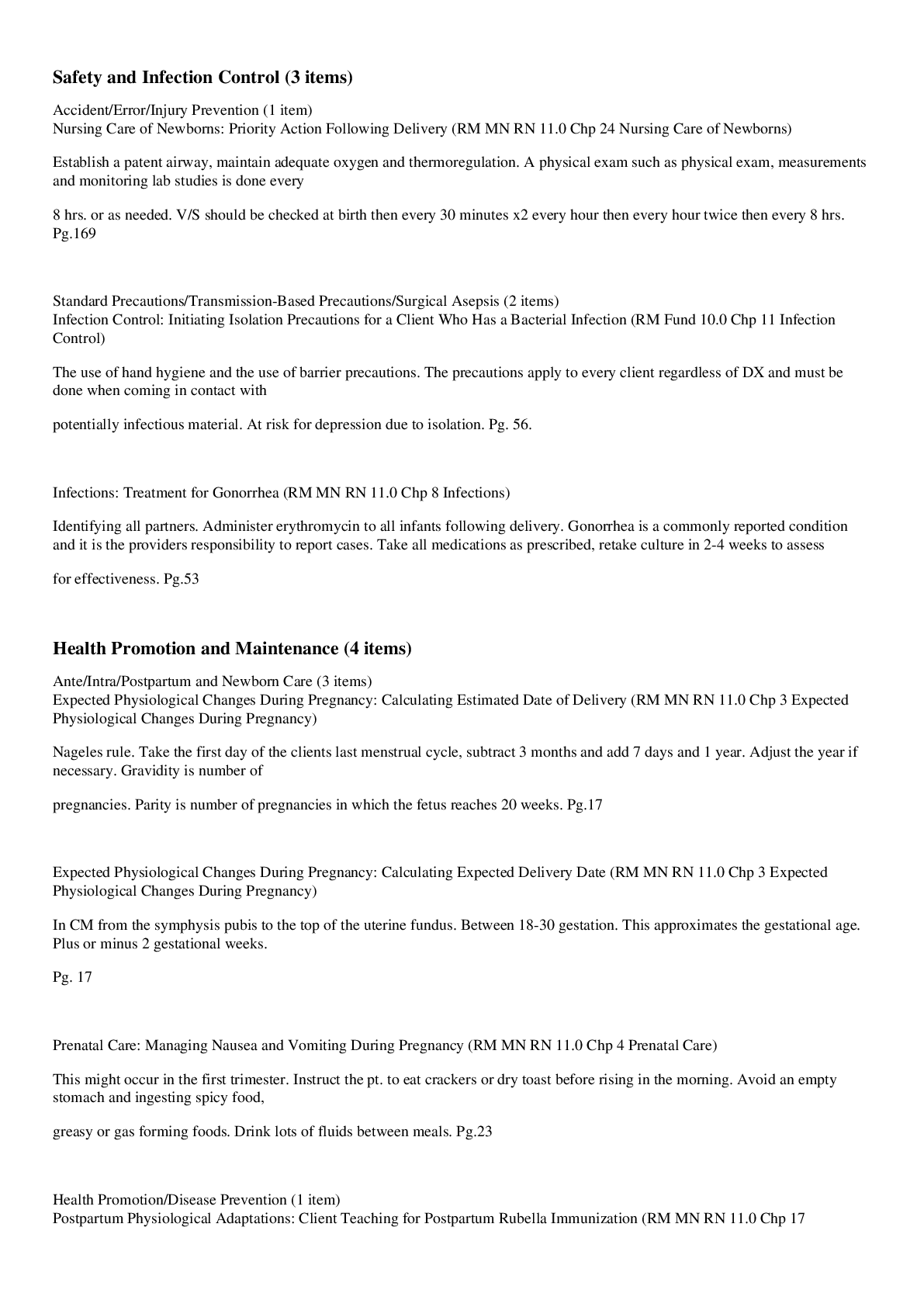
Buy this document to get the full access instantly
Instant Download Access after purchase
Buy NowInstant download
We Accept:

Reviews( 0 )
$8.00
Can't find what you want? Try our AI powered Search
Document information
Connected school, study & course
About the document
Uploaded On
Nov 22, 2022
Number of pages
5
Written in
Additional information
This document has been written for:
Uploaded
Nov 22, 2022
Downloads
0
Views
57







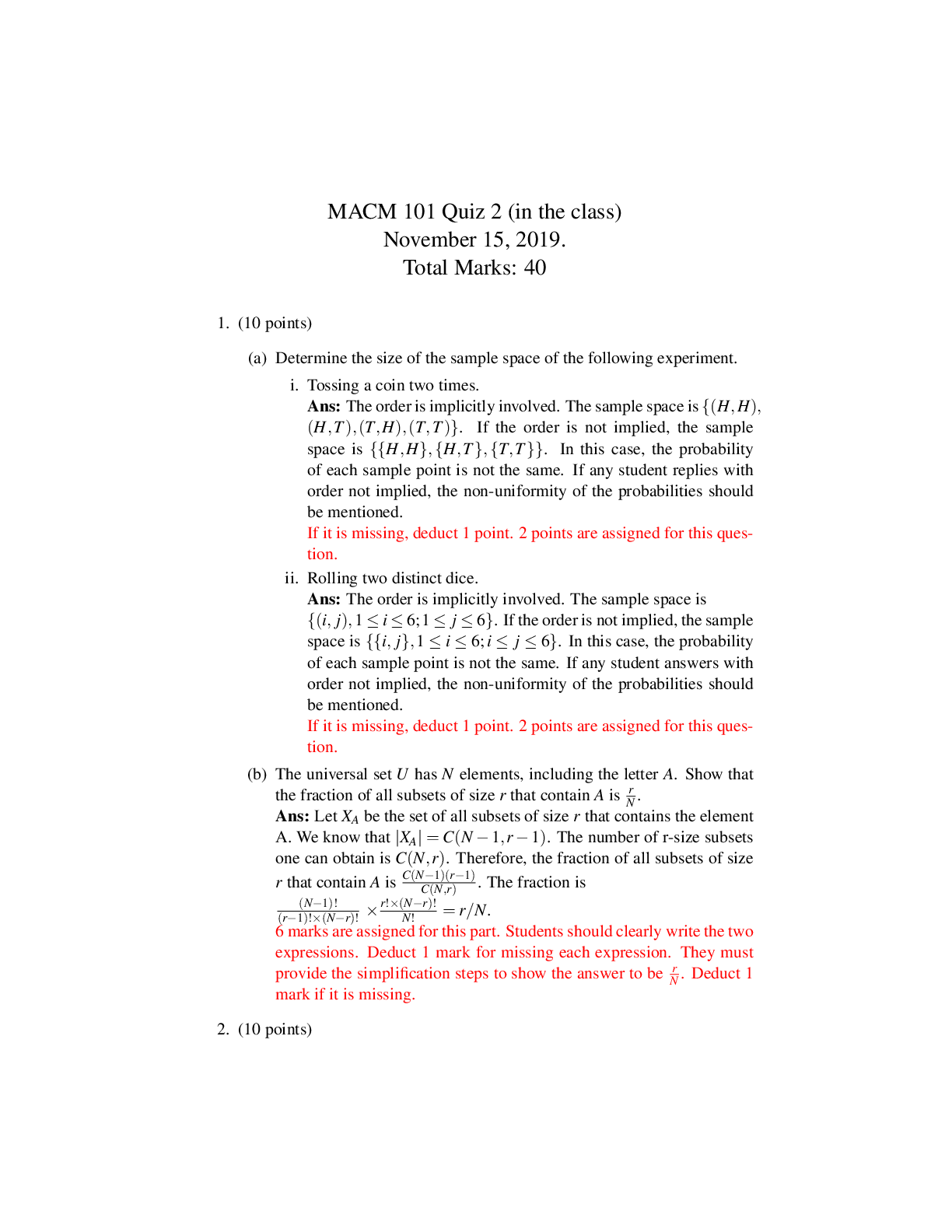





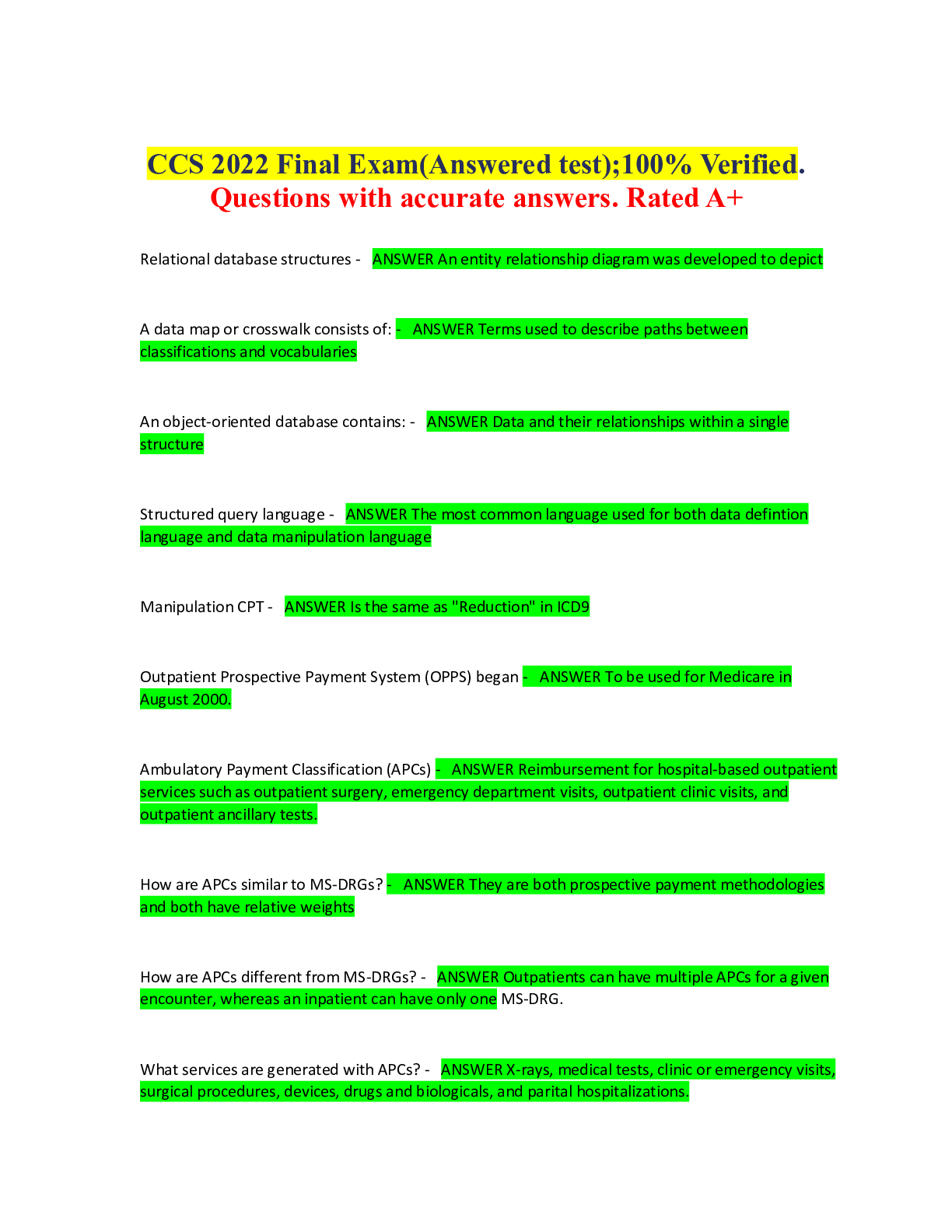


.png)
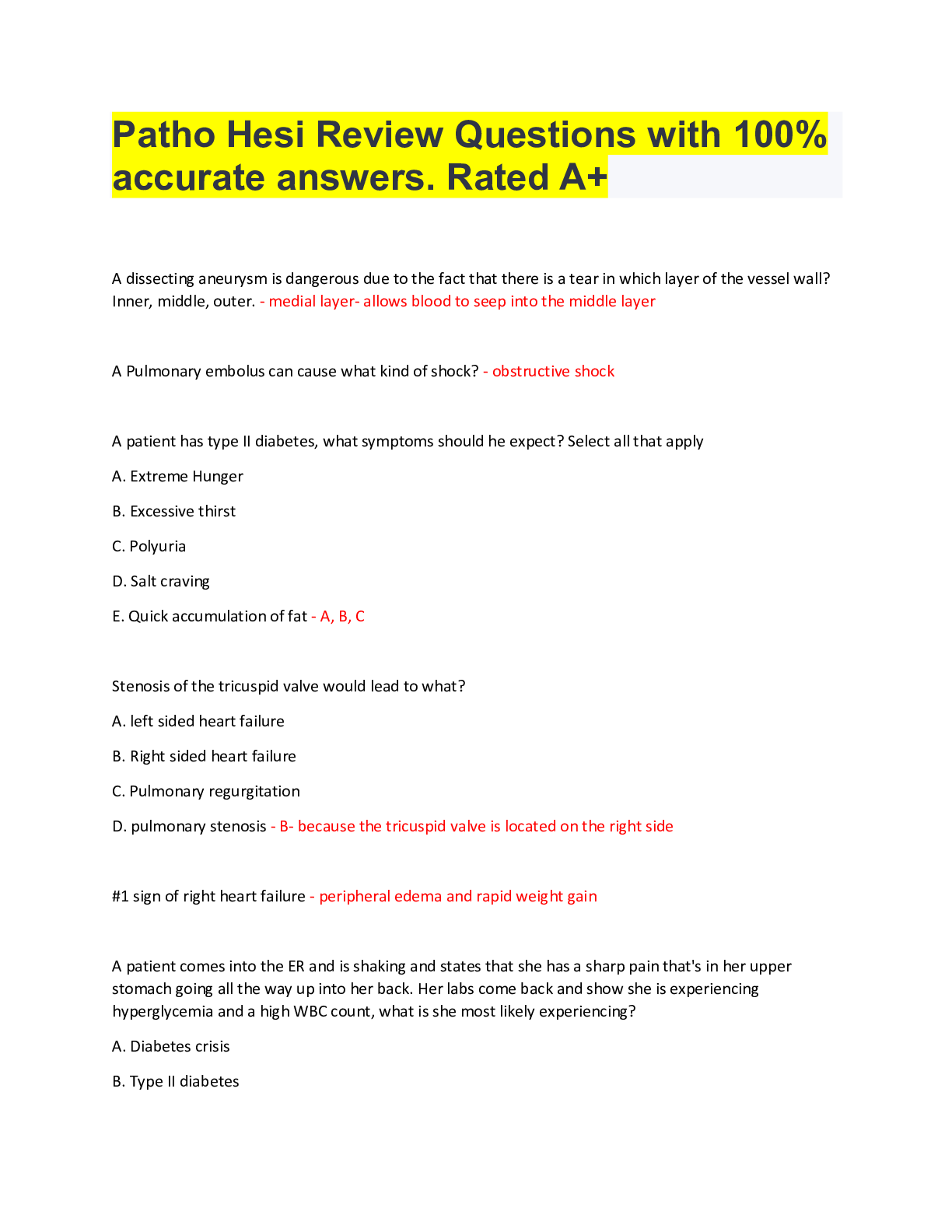
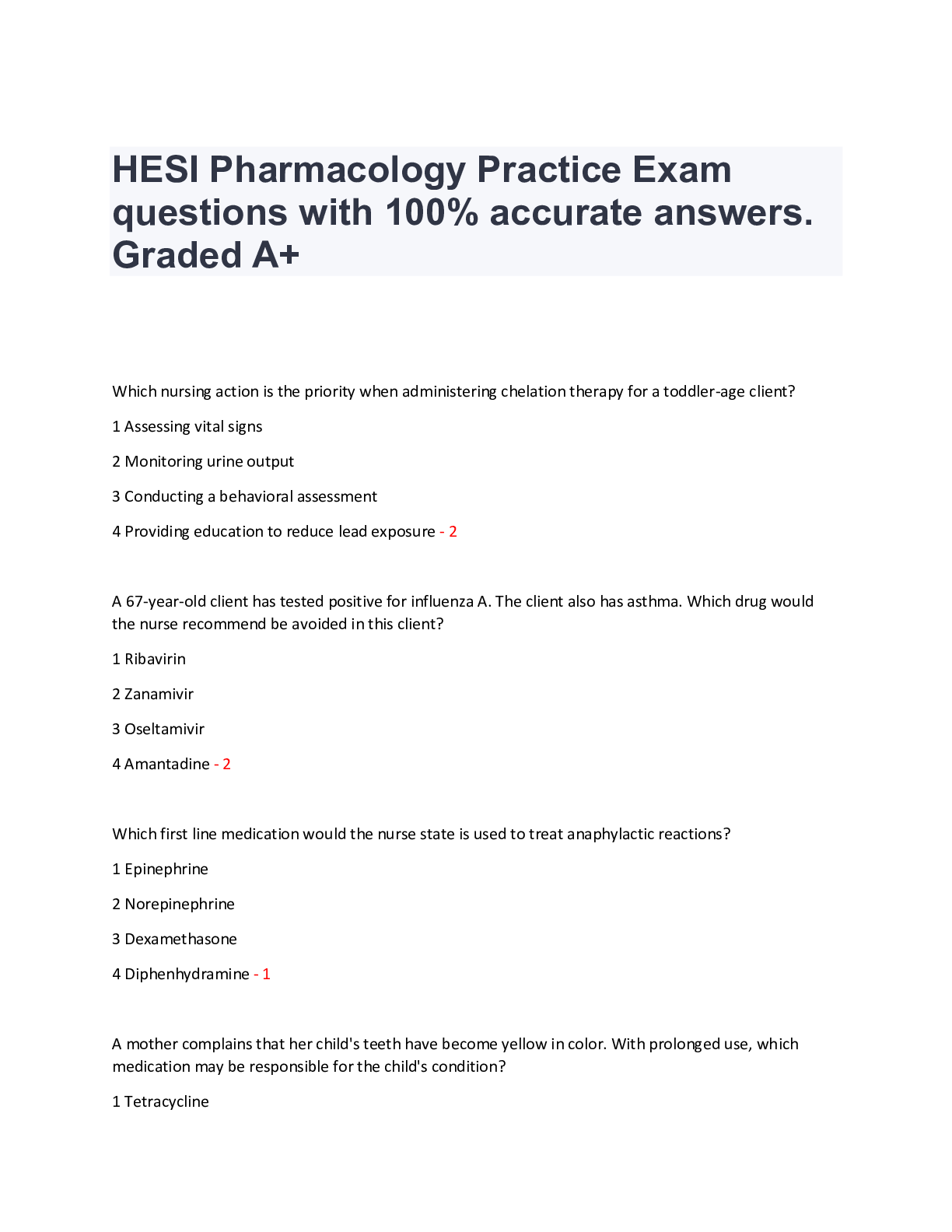
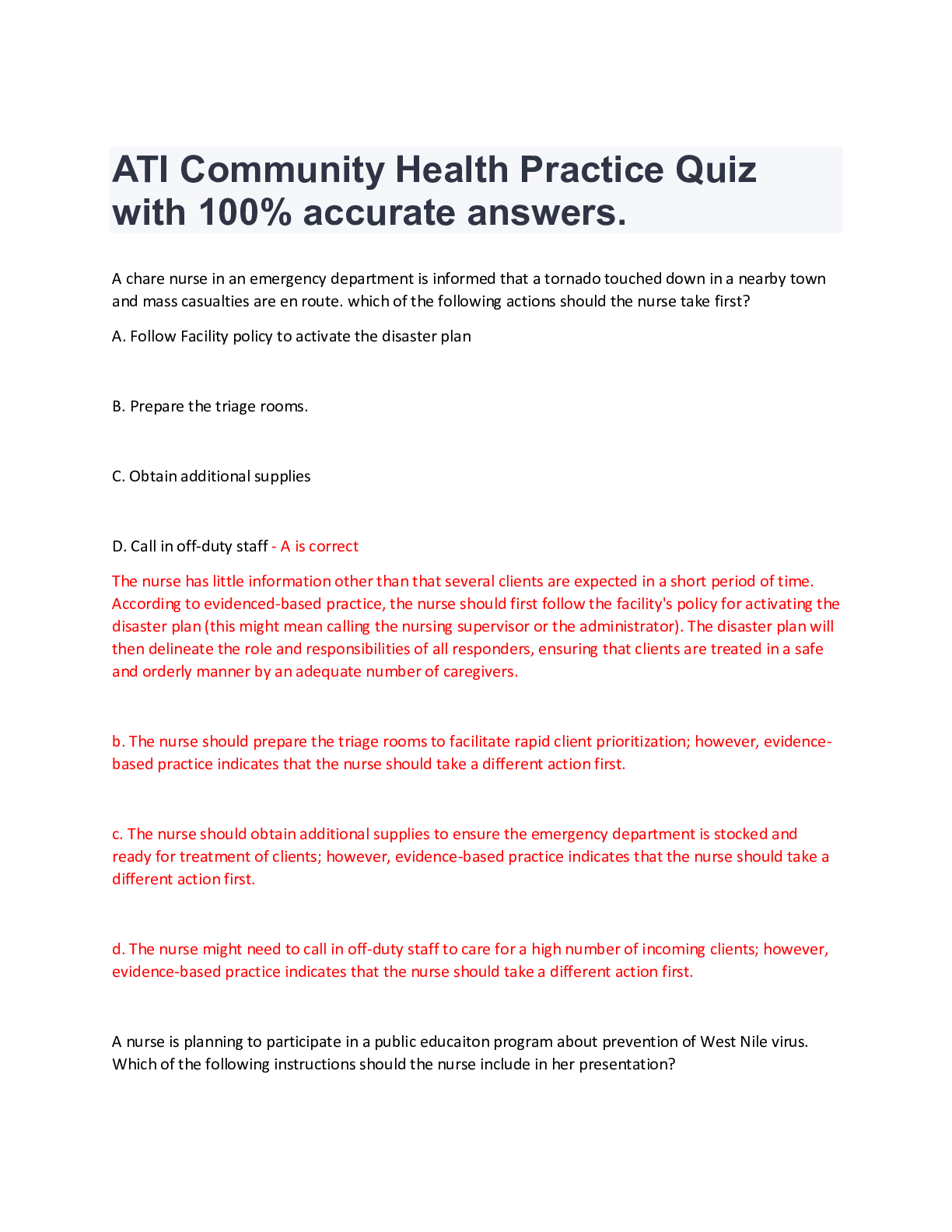
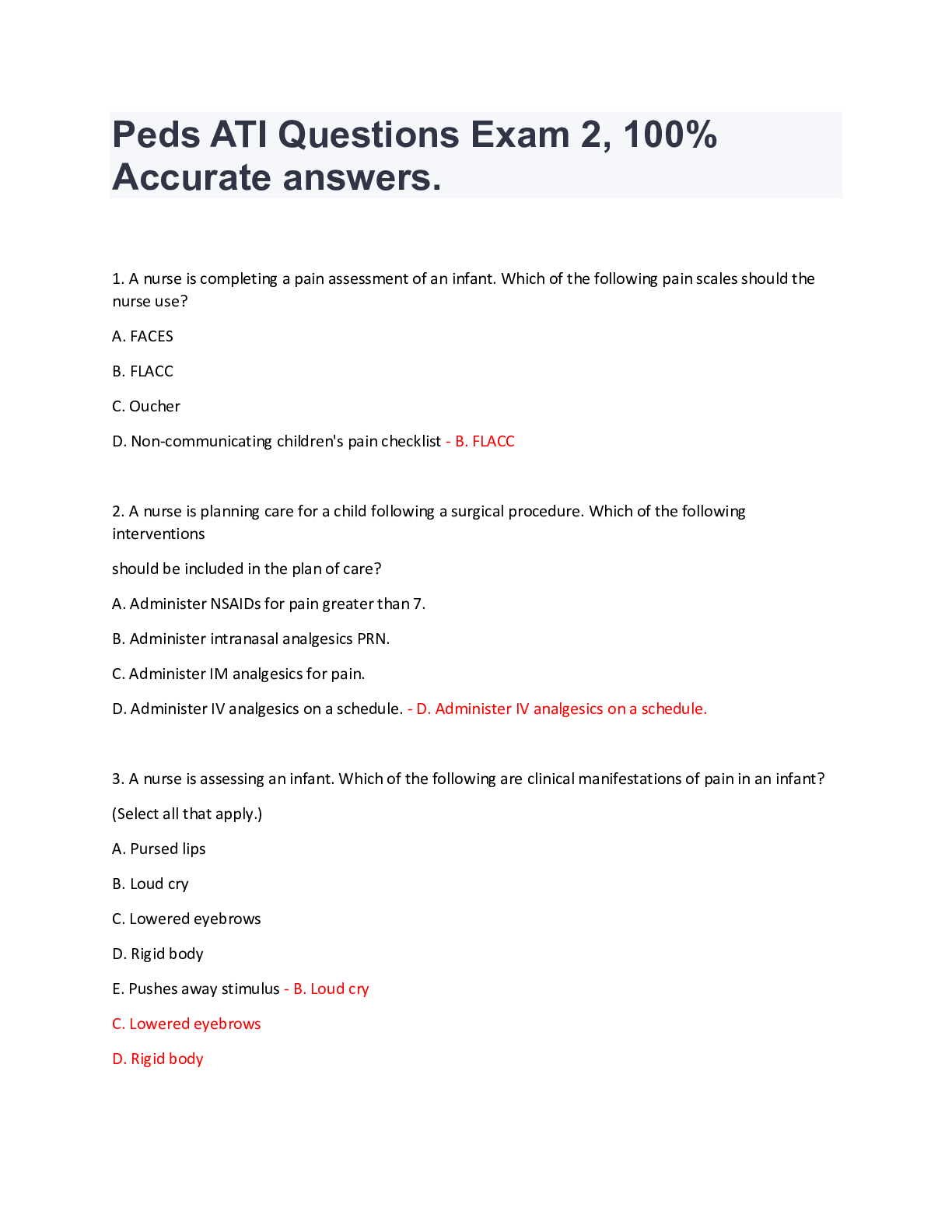
.png)
.png)
.png)


